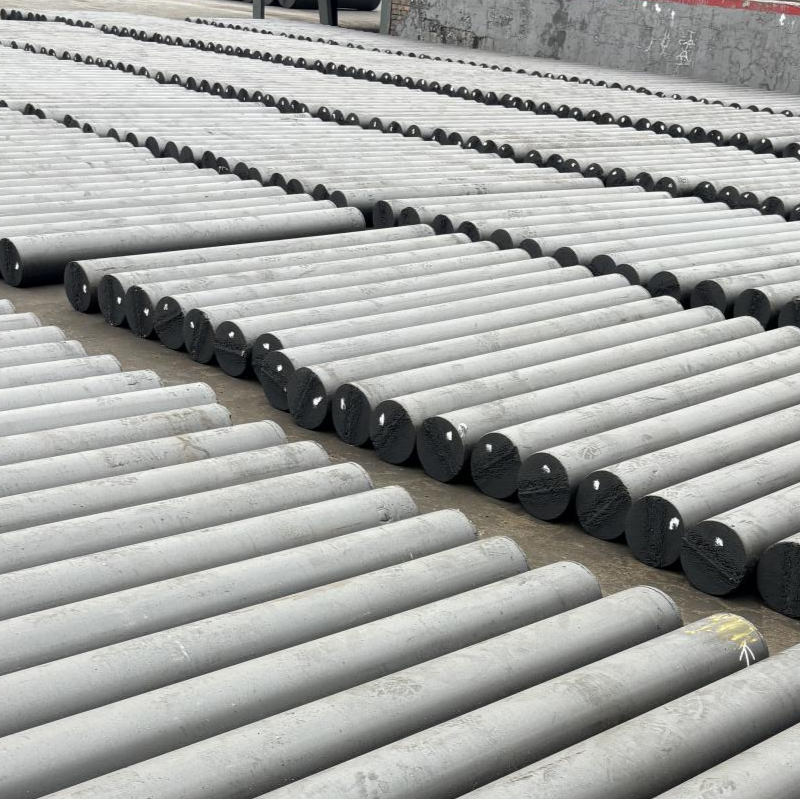
The Fundamental Differences and Application Scenarios of Graphite and Carbon Electrodes
2025-03-12
Graphite and carbon electrodes differ significantly in production methods, physical properties, and applications—defining their roles in metallurgy, electrochemistry, and emerging energy technologies.
1.Material Composition and Manufacturing Process
Graphite electrodes are composed of needle coke and coal pitch and undergo 12 precise manufacturing steps, including graphitization and impregnation. This process results in ultra-high purity (>99% carbon content) and excellent thermal resistance (>3600°C). In contrast, carbon electrodes are produced from metallurgical coke and anthracite through a simpler baking process, achieving a carbon content of 90%–95% at only 1/3 to 1/5 of the cost.
2.Physical Property Comparison
Graphite electrodes feature high rigidity (flexural strength: 15–25 MPa) and low electrical resistivity (5–10 μΩ·m). Their coefficient of thermal expansion (CTE) is as low as 2–4 × 10⁻⁶/°C, ensuring structural stability at elevated temperatures up to 1600°C. Carbon electrodes, in contrast, are more flexible (thickness: 0.1–5 mm), with a higher CTE of 8–12 × 10⁻⁶/°C, making them more suitable for dynamic thermal environments.
3.Application Field Positioning
Graphite electrodes dominate approximately 95% of the electric arc furnace (EAF) steelmaking market, contributing to over 60% of global crude steel output. Large-diameter ultra-high power (UHP) graphite electrodes (e.g., Φ750 mm) are also increasingly used in lithium-ion battery anode production, achieving an 18% reduction in energy consumption. Carbon electrodes, on the other hand, excel in electrochemical applications, such as aluminum electrolysis with 95% current efficiency and capacitive deionization (CDI) with a desalination capacity of 40 mg/g.
4.Industry Development Trends
Leading Chinese manufacturers, such as Fangda Carbon, have achieved mass production of Φ800 mm UHP graphite electrodes, raising China's market share from 65% in 2023 to a projected 75% by 2030. Innovations in carbon electrodes are focused on sustainable applications—for instance, chicken fat-derived carbon electrodes have achieved an energy density of 89 Wh/kg in supercapacitors.
5.Cost-Benefit Analysis
In water electrolysis systems, carbon electrodes offer an initial investment cost that is just 25% that of graphite electrodes but require 30% higher annual maintenance. Conversely, in EAF steelmaking, graphite electrodes save 50 kWh per ton of steel in 1 MTPA plants, translating to annual cost savings of ¥20 million.
6.Future Technological Evolution
Graphite electrode technology is advancing toward a 15% reduction in resistivity through nano-modification. Carbon electrodes are being enhanced with B-N co-doping techniques to achieve thermal conductivity as high as 300 W/(m·K). In response to EU carbon tariffs, industries are accelerating the adoption of clean energy-based calcination, driving further technological differentiation.
Suggested Google SEO Keywords
1.graphite electrodes vs carbon electrodes
2.graphite electrode manufacturing process
3.carbon electrode applications
4.graphite electrode thermal resistance
5.carbon electrode cost analysis
6.flexural strength graphite electrodes
7.low resistivity electrode materials
8.thermal expansion coefficient electrodes
9.UHP graphite electrodes steelmaking
10.lithium battery graphite electrodes
11.carbon electrodes aluminum electrolysis
12.capacitive deionization carbon electrode
13.supercapacitor carbon materials
14.chicken fat derived carbon electrode
15.B-N co-doping carbon electrode
16.graphite electrode nano-modification
17.graphite vs carbon electrode properties
18.clean energy calcination technology
19.EU carbon tariff electrode industry
20.graphite electrode market China


Please leave us a message
- English
- French
- German
- Portuguese
- Spanish
- Russian
- Japanese
- Korean
- Arabic
- Irish
- Greek
- Turkish
- Italian
- Danish
- Romanian
- Indonesian
- Czech
- Afrikaans
- Swedish
- Polish
- Basque
- Catalan
- Esperanto
- Hindi
- Lao
- Albanian
- Amharic
- Armenian
- Azerbaijani
- Belarusian
- Bengali
- Bosnian
- Bulgarian
- Cebuano
- Chichewa
- Corsican
- Croatian
- Dutch
- Estonian
- Filipino
- Finnish
- Frisian
- Galician
- Georgian
- Gujarati
- Haitian
- Hausa
- Hawaiian
- Hebrew
- Hmong
- Hungarian
- Icelandic
















